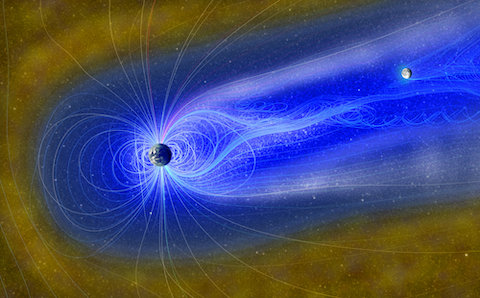
Credit: E. Masongsong, UCLA EPSS, NASA GSFC SVS.
Throughout the Apollo missions, NASA believed there was no water on the Moon.
In the nearly one thousand pounds of rock and soil samples that these missions brought back, they did find traces of water. But they assumed these were contamination from gathering and transport.
Then in 2008, the Indian space agency launched a Moon orbiter carrying NASA’s Moon Mineralogy Mapper—or M3—which was designed to search for minerals, like water.
The tilt of the Moon’s axis prevents sunlight from reaching into some lunar depressions.
M3 used infrared light absorption to discover ice hidden in the dark corners of these craters— especially near the frigid lunar poles.
But the Moon’s atmosphere is too thin to keep water from escaping into space. As it dissipates, how is it being replaced?
Scientists realized that solar wind bathes the Moon in hydrogen ions for three weeks of its four-week orbit around Earth. The hydrogen reacts with oxygen compounds in Moon rocks to form water.
During the one week of full moon, when the Moon is hidden behind Earth, it’s also shielded from the solar wind.
At that time, Earth wind—the tail of our magnetosphere, which is deformed by solar wind into a teardrop that stretches toward the Moon— also bathes it in hydrogen and oxygen.
Without these constant supplies of the building blocks of water, from both Sun and Earth, the Moon would, in fact, be totally dry.
Background
Synopsis: Recent unmanned Moon missions have confirmed the existence of ice, as well as rusty iron oxides, near the lunar poles. With its thin atmosphere, water on the Moon’s surface should evaporate and be lost to the vacuum of space. Yet evidence of water persists. Scientists believe that most of the time, hydrogen ions needed for lunar water are provided by the solar wind. But for about 25% of the lunar cycle, when Earth shields the Moon from the solar wind around the time of the full moon, it is Earth wind, from Earth’s magnetotail, that bathes the Moon in ions like hydrogen that react with oxygen in lunar rocks to replenish lunar hydroxyl (-OH) and water (H2O).
- As Earth’s moon goes through its monthly phases, it always seems to look the same: oceans of basalt peppered with craters, frozen in time.
- In a previous EarthDate (ED-040, The Man in the Moon), we learned that the Moon is synchronized with Earth, orbitally locked so that we see only its near side.
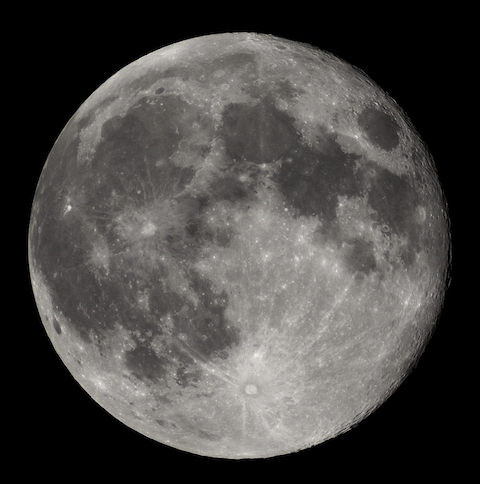
Credit: Luc Viatour, CC BY-SA 3.0, via Wikimedia Commons
- On December 19, 1972, astronaut Gene Cernan stepped from the surface of the Moon back into the lunar module for Apollo 17’s return to Earth. He was the last human to set foot on the Moon.
- The Apollo missions explored the brightly lit equatorial regions on the near side of the Moon, and they never visited during the full moon.
- Scientists of the Apollo era believed the Moon to be bone-dry, reasoning that the limited lunar atmosphere could not prevent water vapor from escaping into space.
- The 842 lb (382 kg) of soil and rock specimens returned to Earth during the Apollo program supported that preconceived notion, and any hints of water in the samples were attributed to contamination.
- In the five decades since Apollo 17’s voyage, unmanned lunar missions have continued to reveal many of the Moon’s secrets—including the presence of lunar water.
- Over the decades, other tools had hinted at the presence of hydrogen on the lunar surface but could not distinguish whether the hydrogen was associated with hydrous minerals or water.
- In 2008, the Indian Space Research Organization launched the Chandrayaan-1 orbiter, which was carrying a variety of tools, including NASA’s Moon Mineralogy Mapper (M3).
- The M3 was designed not just to detect minerals like water, but to use infrared light absorption to distinguish among water vapor, liquid water and solid ice.
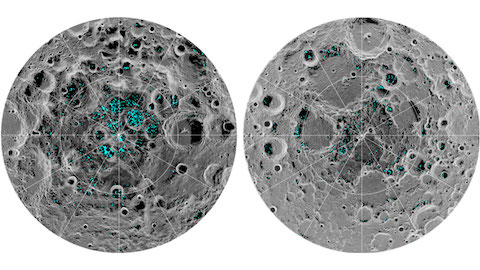
Credit: NASA
- The slight tilt of the Moon’s rotational axis prevents sunlight from ever touching portions of some lunar depressions. These are called permanently shadowed regions (PSRs).
- The M3 confirmed that ice is hidden in the eternal darkness of these PSRs, especially those near the lunar poles, where temperatures rarely exceed -250°F (-157°C).
- Ice is concentrated in craters near the southern pole but is more dispersed around the northern pole.
- Since 2009, NASA’s Lunar Reconnaissance Orbiter (LRO) has mapped PSRs on the lunar surface, creating an extensive atlas.
- When an impact probe from the LRO deliberately crashed into one of the PSRs, the LRO analyzed the plume of dust from the impact, which contained an estimated 340 lb (155 kg) of water.
- In 2018, detailed analysis of the 2009 M3 data revealed that above 70° latitude, lunar water-ice concentrations range from 2% to 30%.
- Additional water may exist in blocks or sheets below the surface and be contained in hydrous minerals in Moon rocks.
- Comets and asteroids are known to contain water and have clearly pummeled the Moon, so the ice could be billions of years old.
- Ice on the Moon could be a resource for future expeditions or Moon bases, including being a source for hydrogen and oxygen for rocket fuel.
- Finding water on the Moon is exciting, but how does that water persist over billions of years on a body with an atmosphere too thin to prevent water vapor from escaping into space? How is it replenished?
- Like solar plasma, solar wind contains about 90% ionized hydrogen, 8% helium, and trace amounts of other solar fusion materials.
- The Moon’s dayside surface is bombarded by solar wind for three weeks every month. During this period, positively charged hydrogen ions spontaneously react with materials on the lunar surface, producing hydroxyl (-OH) and molecular water (H2O).
- Scientists determined that without a supply of hydrogen ions from the solar wind for the last week of the lunar month, evaporation should cause half of the lunar water ice at high latitudes to disappear, drying out the surface. But that does not happen.
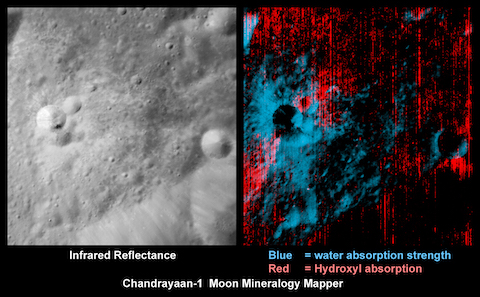
Credits: ISRO/NASA/JPL-Caltech/USGS/Brown Univ.
- Solar wind blasts out of the Sun continually at >1 million mph (>1.6 million kph), blowing Earth’s magnetosphere into an extended teardrop shape with a long magnetotail pointing downwind, away from the Sun.
- During the week of the full moon, Earth is between the Sun and Moon, so Earth’s magnetotail points directly toward the Moon, shielding it from the solar wind. But that is not all that it does. The tail produces Earth wind.
- Earth’s magnetic poles continually shoot ionized hydrogen, helium, oxygen and nitrogen into space. It is a small amount compared to our atmosphere, but it charges up the magnetosphere’s Earth wind.
- Careful analysis of water surface maps before, during and after the Moon’s transit through the magnetotail indicate that Earth wind provides a richer flow of earthly magnetospheric ions than solar wind. This can seed water-producing reactions.
- Earth’s magnetotail whips back and forth, bathing the full moon repeatedly with hydrogen, helium, oxygen and nitrogen ions and compounds.
- Recent analyses have shown that the polar regions of the Moon contain oxidized hematite (Fe2O3), commonly known as rust. The oxygen component of Earth wind appears to be rusting iron minerals on the Moon.
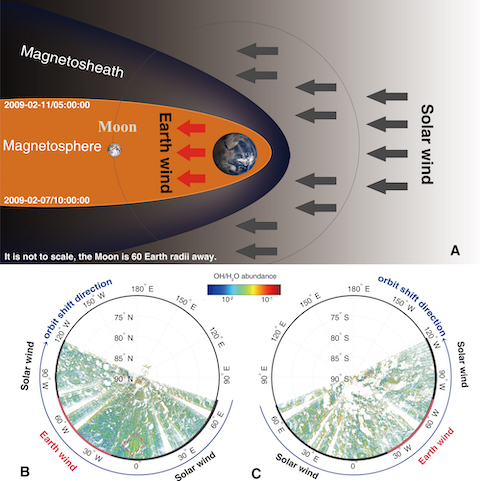
Credit: Wang and others (2021), The Astrophysical Journal Letters
- If you can see the full moon, you can be sure it is being shielded and enriched by Earth wind from Earth’s invisible magnetic tail—and probably rusted, too.
- Humans have never experienced Earth wind while on the Moon: none of the Apollo missions occurred during the full moon. Extreme voltage variation may be a hazard of a manned Moon mission experiencing Earth wind.
- During the new moon phase, Earth is in the path of Moon wind.
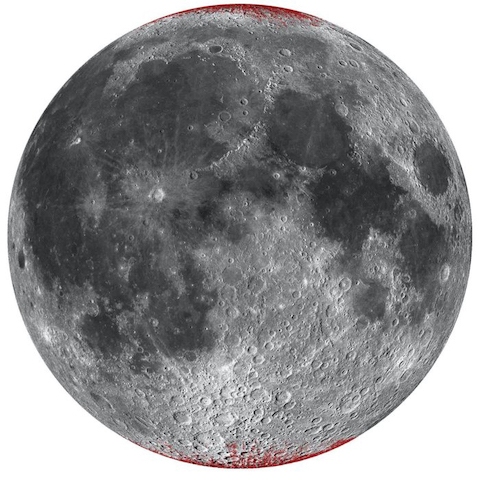
Credit: Shuai Li, Hawai'i Institute of Geophysics and Planetology (HIGP) in the UH Mānoa School of Ocean and Earth Science and Technology (SOEST)

